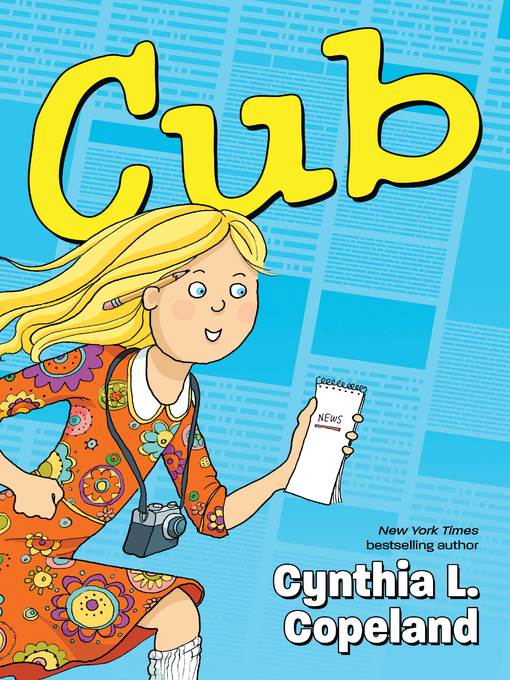
Cub
فرمت کتاب
ebook
تاریخ انتشار
2020
Reading Level
0-2
ATOS
3.3
Interest Level
4-8(MG)
نویسنده
Cynthia L. Copelandناشر
Algonquin Booksشابک
9781643751030
کتاب های مرتبط
- اطلاعات
- نقد و بررسی
- دیدگاه کاربران
نقد و بررسی

November 1, 2019
Gr 4-7-In this wholesome graphic memoir, Copeland recounts the ups and downs of middle school life in the early 1970s. Twelve-year-old aspiring writer Cindy always had trouble fitting in at school, but she cracked the code to the wild kingdom of Litchfield Junior High School: avoid the attention of the mean girl clique (aka the predators) by acting boring and "playing dead." After her teacher Ms. Shultz sets her up with an internship with the Torrington Register, Cindy spent seventh grade shadowing local reporter Leslie Jacobs. As the year unfolded, Cindy developed her skills as a cub reporter and thrived in the face of evolving friendship worries. Eye-catching design elements such as copyedited article rough drafts and comics panels that look like snapshots make Copeland's experiences especially absorbing. Subplots involving bullying and first crushes are blander but still relatable, and the jungle analogies will ring true with readers who are navigating similar middle school drama. While the narrative will empower many readers, dated, cartoonish illustrations that are more appropriate for a picture book limit the emotional impact. VERDICT Hand this to tweens and teens who want a gentle read about growing up. For large graphic novel collections.-Pearl Derlaga, York County Public Library, VA
Copyright 2019 School Library Journal, LLC Used with permission.

Starred review from October 14, 2019
In her debut graphic novel for young readers, Copeland (Middle School Secrets) presents a memoir set in 1972–1973, when the then-12-year-old job-shadowed a local news reporter. If the lingo (“far out!”), heartthrobs (John Denver), and fads (sea monkeys) are dated, the references to Troll dolls, Earth Day, and Watergate have direct, contemporary links. When Cindy’s best friend takes up with “the predators,” three stylish girls whose clique name is inspired by both Jaws and Wild Kingdom, Cindy joins a goofy but loyal circle. Concurrently, the ERA makes headlines, and Cindy’s father talks about careers only with his sons. After Cindy meets Leslie, a lone “female reporter” at a daily paper, she gains confidence by practicing writing and photography. Engaging full-color illustrations include Leslie’s handwritten edits of the cub reporter’s typewritten ledes. Deftly juggling Cindy’s school days, internship, and home life, Copeland crafts a multilayered, year-in-the-life story within a complex historical context: “Our country is in turmoil: chaos in the White House, a senseless war, environmental crises, women having to fight for equal rights.” Ages 8–12. Agent: Daniel Lazar, Writers House.

Starred review from September 15, 2019
In the fall of 1972, Cindy Copeland sees nature's game of predator versus prey playing out in the halls of Litchfield Junior High School. Donning long, Amish-like dresses and fitted with braces, she's certain of her destiny as prey, subject to the mean girls that sit at the predators' table. Instead, her favorite English teacher arranges for her to work with a local newspaper journalist as a "cub reporter." Her new mentor is a young, hip reporter who drives a VW Beetle and wears bellbottoms. Meanwhile, Cindy's best friend starts hanging out at the predators' table, leaving the protagonist for the first time without her childhood BFF. As Cindy becomes a more adept reporter, her confidence grows and she develops new friendships; she even acquires her first boyfriend. News assignments are followed by examples of rough drafts with corrections and notes showing the editorial process. As a cub reporter, Cindy is exposed to contemporaneous issues: the 1972 presidential election campaign, Earth Day, and Connecticut's ratification of the Equal Rights Amendment. Copeland's first graphic novel for kids successfully integrates the right balance of coming-of-age issues into those arising from her early-'70s setting; many of the latter are eerily similar to those that the country is still experiencing. Cindy is white; one of her new friends is one of their school's few students of color. This tale of middle-grade angst and self-consciousness is laced with humor and nostalgia. (Graphic memoir. 8-12)
COPYRIGHT(2019) Kirkus Reviews, ALL RIGHTS RESERVED.

January 1, 2020
Grades 5-8 Seventh grade is a struggle for just about everyone, and while Copeland had her fair share of middle-school angst, it was also the year she became a bona fide writer. An internship with a local reporter (one of few women in the field) allowed Copeland to hone her journalistic skills, and she flourished as a result, giving her the self-confidence to deal with everything from school bullies to misguided first attempts at dating. This positive and empowering graphic memoir is drawn in a simple, appealing cartoony style that reflects the straightforward narrative arc. Backgrounds and settings are minimal, allowing the reader to focus on the emotional heart of Copeland's story without distraction. Some details, such as early 1970's pop-culture references, may not resonate with today's middle-schoolers, but Copeland's experiences, such as her drive for validation from her father and the constantly shifting alliances among friends, certainly will. With a gentle tone and absence of any real trauma, this will appeal to fans of Svetlana Chmakova's Berrybrook Middle School series and similar titles.(Reprinted with permission of Booklist, copyright 2020, American Library Association.)

























دیدگاه کاربران